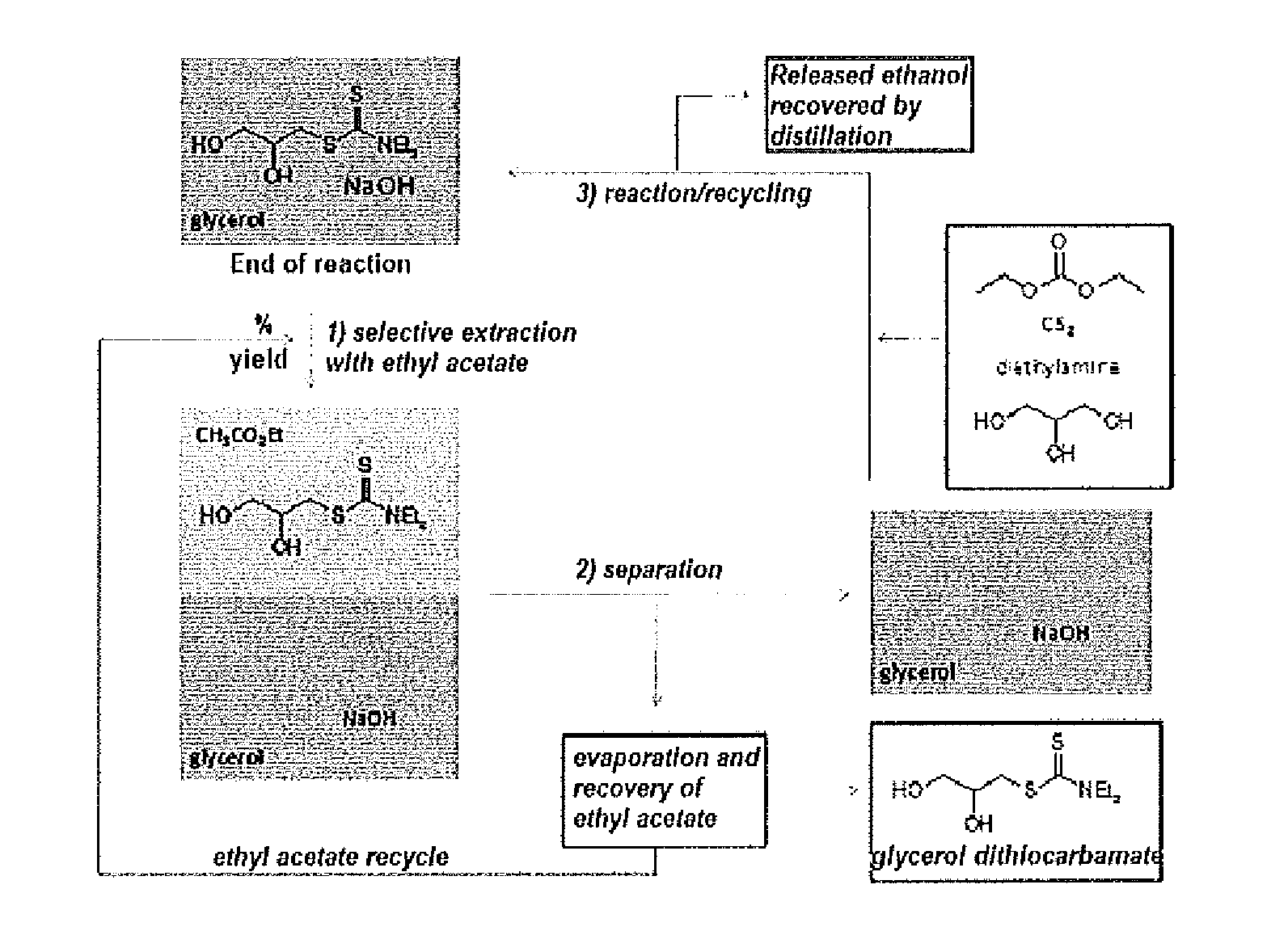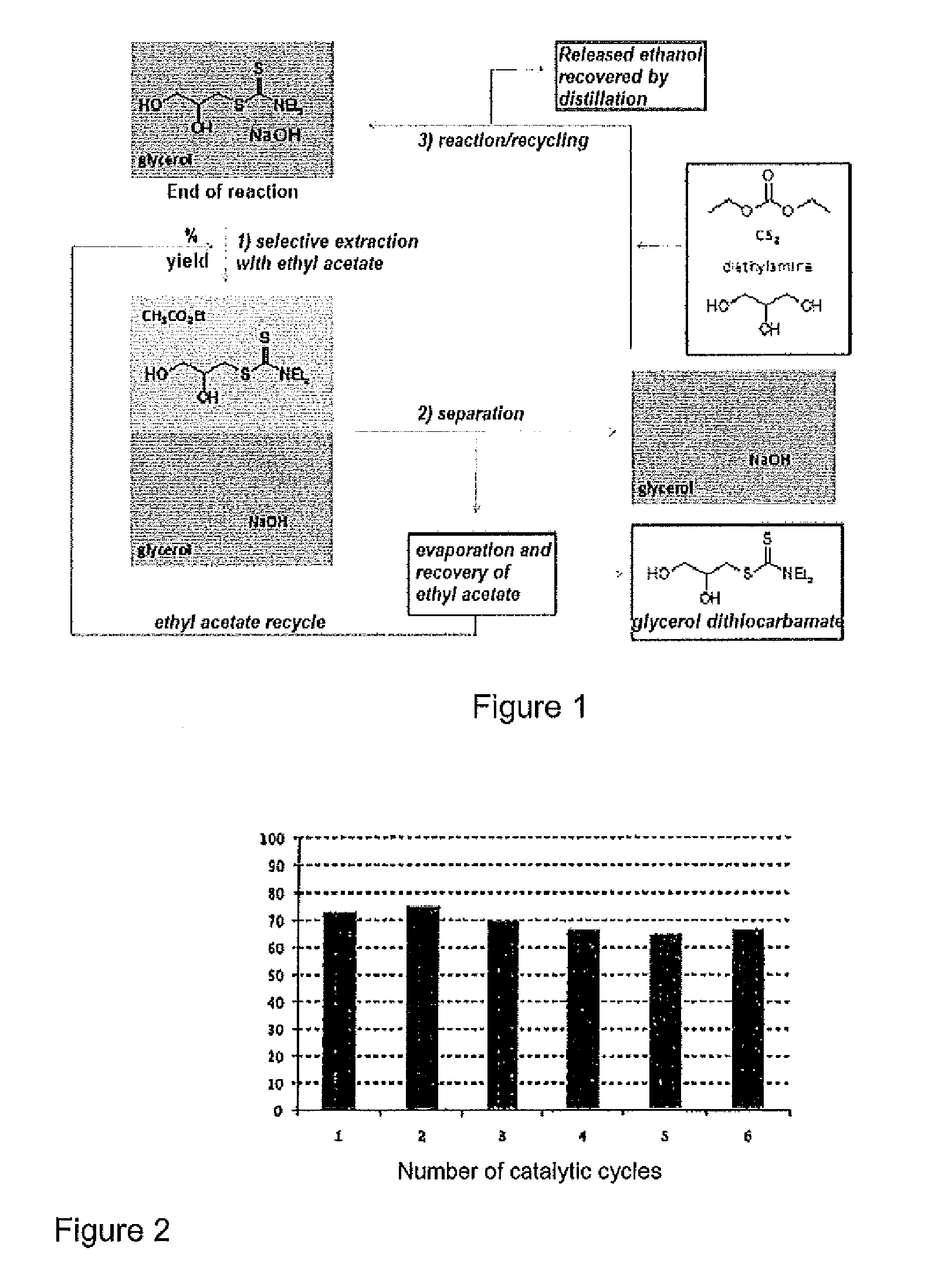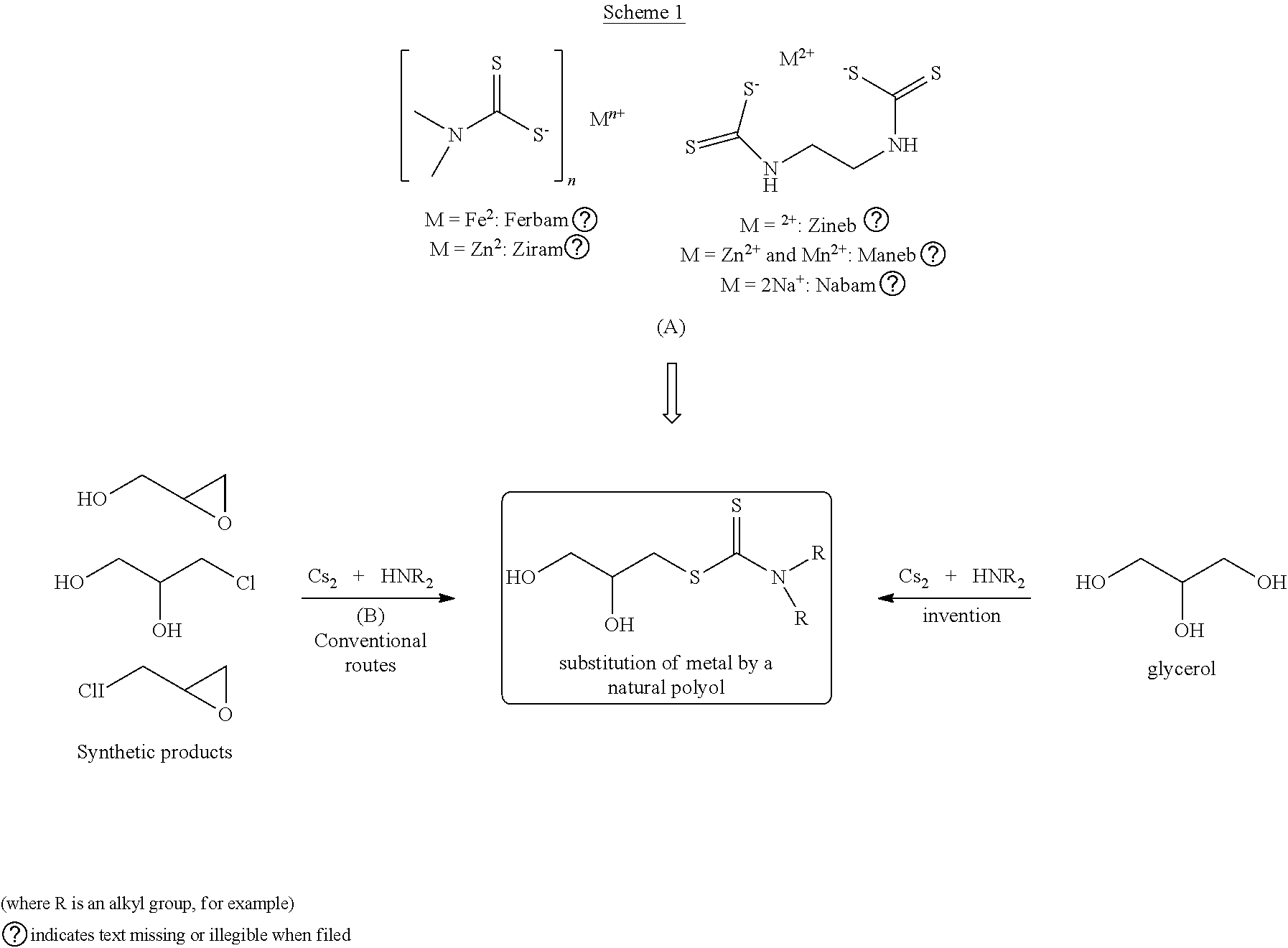Method for preparing dithiocarbamates in particular from polyols of the glycerol type
- Summary
- Abstract
- Description
- Claims
- Application Information
AI Technical Summary
Problems solved by technology
Method used
Image
Examples
example 1
Synthesis
[0092]
[0093]Using the following general operating procedure:
[0094]The polyol (84.5 mmole) was mixed with 16.9 mmole of diethyl carbonate in the presence of 2% molar of NaOH; during this step the ethanol was continuously distilled and recovered. After 1 hour of reaction at 130° C., 19.9 mmole of CS2 and 16.9 mmole of amine were added to the medium which was stirred, at 60° C., for the whole period H.
TABLE 1R1R2 / R3PeriodIsolatedCompoundpolyolAmine (*)H (h)Productyield (%) 1—CH2OH—Et1575 2—CH2OH—iPr2475 3—CH2OH—(CH2)5*2470 4—CH2OH—CH2OH2460 5—CH2OH—nBu2463 6—CH3—Et2475 7—CH3—(CH2)5*2471 8—CH3—iPr2455 9—H—Et248110—H—iPr246912—CH2OH—nOc*2455R2 = R3 or (*) —NR2 / R3 = cycloamino
[0095]At the end of the indicated period H, the corresponding glycerol dithiocarbamate was obtained in the yield indicated in Table 1 above.
[0096]Ethylene glycerol and 1,2-propandiol were successfully used in place of glycerol, resulting in the corresponding dithiocarbamates (compounds 6 to 10 and 12).
[0097]...
example 2
2,3-dihydroxypropyl diethyldithiocarbamate (compound 1)
[0098]
[0099](yellow-brown oil in a mixture of ethyl acetate / heptane=3 / 7)
[0100]1H NMR δ 1.27 (t, J=7.1 Hz, 3H), 1.28 (t, J=7.1 Hz, 3H), 2.84 (s, 1H), 3.37 (s, 1H), 3.51 (dd, J=14.5 Hz, J=6.5 Hz, 1H), 3.75 (q, J=7.2 Hz, 2H), 3.78 (t, J=7.1 Hz, 2H), 4.02 (t, J=7.1 Hz, 2H);
[0101]13C NMR δ 11.3, 12.2, 40.8, 46.3, 48.9, 64.9, 69.8, 194.6 10.2, 10.4, 30.8, 31.0, 61.1, 62.4, 64.0, 64.2, 70.1, 70.2, 70.9, 71.1, 82.8, 84.5, 84.6, 126.7, 126.8, 127.6, 127.8, 128.4, 128.5, 141.9, 142.4.
[0102]IR (pure) 3365, 2975, 2932, 2873, 1631, 1488, 1442, 1416, 1379, 1354, 1300, 1268, 1204, 1142, 1090, 1067, 1005, 981, 915, 880, 832, 776 cm−1;
[0103]LC.MS: [M+Na+]: m / z=246
example 3
2,3-dihydroxypropyl piperidine-1-carbodithioate (compound 3)
[0104]
[0105](yellow oil in a mixture of ethyl acetate / heptane=3 / 7)
[0106]1H NMR δ 1.71 (m, 6H), 3.55 (dd, J1=14 Hz, J2=7 Hz, 1H), 3.6-3.75 (m, 3H), 3.9-4 (m, 3H), 4.3 (m, 2H), 3.77-3.82 (m, 1H), 4.12 (t, J=6.7 Hz, 0.9 μl), 4.30 (t, J=6.8 Hz, 0.1H), 7.21-7.34 (m, 5H);
[0107]13C NMR δ 24.2, 25.5, 26, 39.2, 51.7, 53.8, 64.6, 71.4, 195.7;
[0108]IR (pure) 3406, 2859, 1789, 1743, 1476, 1427, 1366, 1373, 1352, 1227, 1179, 1113, 1072, 1050, 1004, 975, 892, 853, 776, 711 cm−1;
[0109]LC.MS: [M+Na+]: m / z=258
PUM
| Property | Measurement | Unit |
|---|---|---|
| Fraction | aaaaa | aaaaa |
| Fraction | aaaaa | aaaaa |
| Fraction | aaaaa | aaaaa |
Abstract
Description
Claims
Application Information
 Login to View More
Login to View More - R&D
- Intellectual Property
- Life Sciences
- Materials
- Tech Scout
- Unparalleled Data Quality
- Higher Quality Content
- 60% Fewer Hallucinations
Browse by: Latest US Patents, China's latest patents, Technical Efficacy Thesaurus, Application Domain, Technology Topic, Popular Technical Reports.
© 2025 PatSnap. All rights reserved.Legal|Privacy policy|Modern Slavery Act Transparency Statement|Sitemap|About US| Contact US: help@patsnap.com



